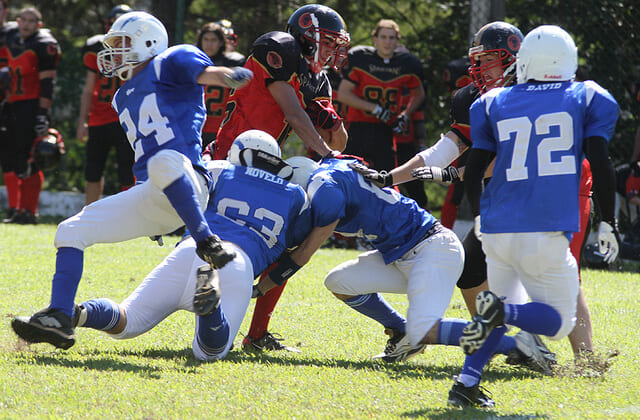Almost Half of Young Players Concussions Caused by Front of Head Contact

High school football players are more likely to lose consciousness after concussions if they get hit at the top of the head compared to the sides, back or front, according to a new study.
And nearly half of all concussions suffered by high school players occur from player-to-player collisions on the front of the head, the researchers found.
The findings support a growing movement for safer tackling. Football players are more likely to get hit at the top of the head if they tackle with their heads down, according to the study.
“Something as simple as lifting their heads up when they’re tackling can prevent fatal and catastrophic injuries,” said study lead author Zachary Kerr, director of the NCAA Injury Surveillance Program at Datalys Center for Sports Injury Research and Prevention in Indianapolis.
Experts are paying more attention to concussions at all levels of football because of increasing awareness about the risks of permanent brain injury.
Concussions often occur in contact sports like football where blows to the head are likely. They can cause headache, dizziness, loss of consciousness and other symptoms.
In the new study, published online Aug. 11 in Pediatrics, researchers reviewed more than 2,500 reports of high school football-related concussions in the United States for the school years 2008-09 and 2012-13. All of the concussions resulted from player-to-player collisions — almost 60 percent during games, the rest at practices.
Of the concussions, 45 percent occurred from injuries to the front of the head. Impacts to the side of the  head (22 percent), back of the head (6 percent), and top of the head (6 percent) accounted for the rest where a cause was reported.
head (22 percent), back of the head (6 percent), and top of the head (6 percent) accounted for the rest where a cause was reported.
The researchers found that the location of the impact didn’t affect the symptoms or prognosis for the players, Overall, they were likely to suffer headaches (93 percent), dizziness and unsteadiness (76 percent), difficulty concentrating (61 percent), and confusion and disorientation (52 percent).
However, athletes hit at the top of the head were more likely to be knocked unconscious (8 percent) compared to those smacked somewhere else on the head (3.5 percent lost consciousness).
Kerr said it’s clear that injuries from top-of-the-head impacts are usually more severe than others.
Loss of consciousness boosts the risk that recovery will take longer, said Steven Broglio, director of the NeuroSport Research Laboratory at the University of Michigan in Ann Arbor.
About 90 percent of athletes will recover from concussions in about two weeks when they’re treated correctly, he said. But loss of consciousness greatly increases the chance these athletes will be in the 2-3 percent whose symptoms last longer than six weeks.
“Players should always look at what they are hitting and avoid using their head as the initial point of contact with their opponent,” Broglio said. “In addition to increased concussion risk, head-down tackling and hitting with the top of the helmet are a mechanism for neck fracture.”
Kerr agreed. “We need to continue to teach athletes to tackle appropriately with their heads up and teach awareness about concussions and the proper fitting of helmets,” he said.
“Helmets come in different sizes. It’s not just a ‘one-size fits all,'” Kerr said. “Coaches, parents and players should know how to properly measure for helmets, adjust the fit when needed, and conduct equipment checks and maintenance.”
By Randy Dotinga
HealthDay Reporter
More information
For more about concussion, try the CDC.
SOURCES: Zachary Kerr, Ph.D., MPH, director, NCAA Injury Surveillance Program, Datalys Center for Sports Injury Research and Prevention, Indianapolis, Ind.; Steven P. Broglio, Ph.D., director, NeuroSport Research Laboratory, University of Michigan, Ann Arbor; September 2014, Pediatrics
Last Updated: Aug. 11, 2014
Copyright © 2014 HealthDay. All rights reserved.
